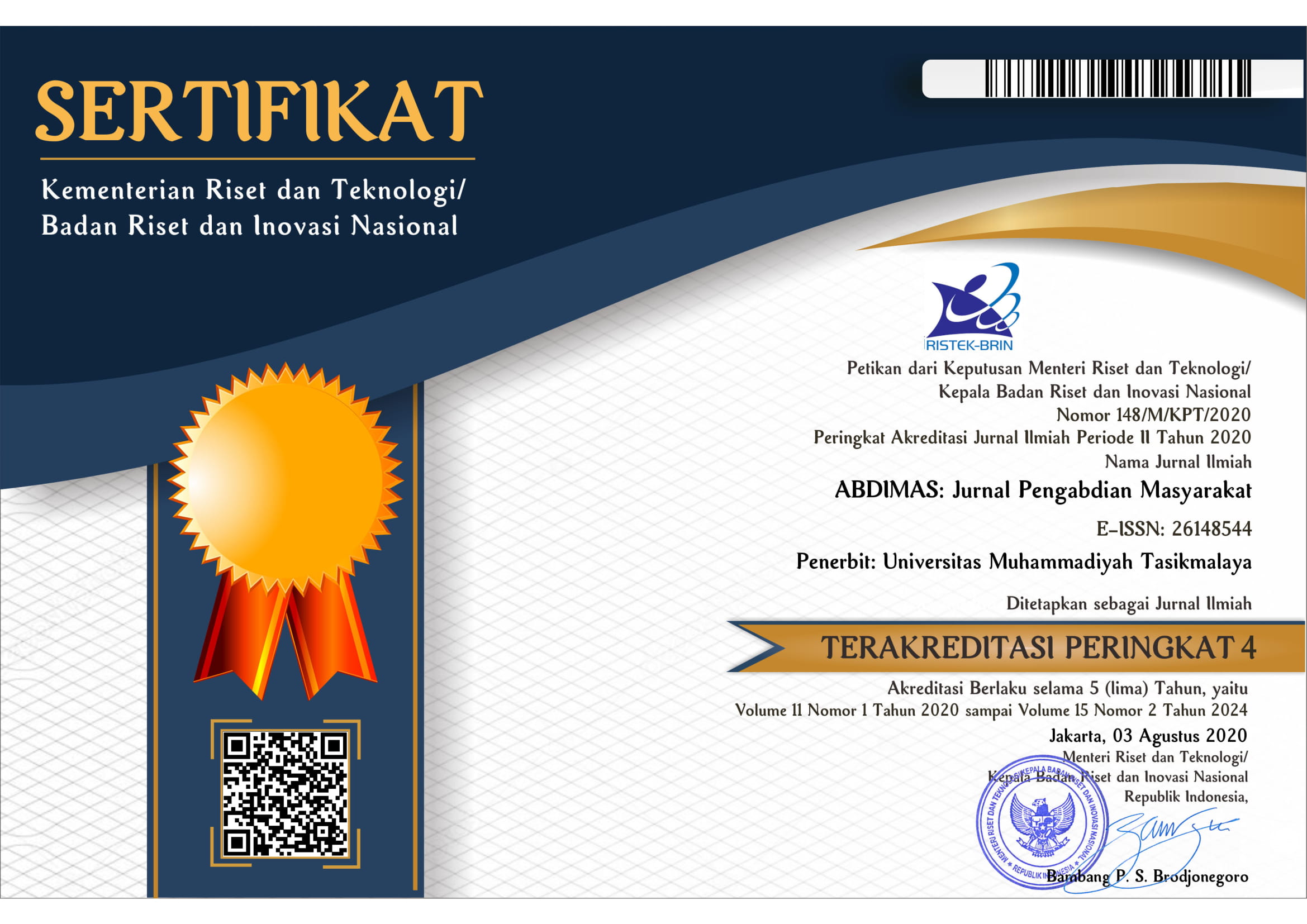Education in Making Complementary Food at Posyandu Cempaka and Edelweis, Kahuripan, Tasikmalaya
DOI:
https://doi.org/10.35568/abdimas.v6i4.3987Keywords:
complementary food, education, under two years old childrenAbstract
At the age of six months to two years, infant need breast milk complementary food. Mothers' ignorance about providing nutritious complementary foods can lead to low nutritional intake which ultimately results in stunted growth. This community service activity aims to increase mothers' knowledge about making breast milk complementary food through education. Participants in this activity were 70 mothers who had children under two years old in two posyandu (Cempaka and Edelweiss) at the Karuripan Community Health Center, Tasikmalaya City. The methods used in this activity include needs assessment, creating educational materials, implementing education (explaining and providing examples of how to make complementary food) and evaluation by administering pre-tests and post-tests. The results of this activity have a positive influence on increasing mothers' knowledge about making MP ASI, so that similar activities need to be carried out regularly.
Downloads
References
Ainy, A., Misnaniarti, Fatmalina Febry, & Dian Safriantini. (2021). Potential Barriers in Implementing Local-Food-Based Complementary Feeding Practice. Jurnal Ilmu Kesehatan Masyarakat, 12(2), 117–127. https://doi.org/10.26553/jikm.2021.12.2.117-127
Aprillia, Y. T., Mawarni, E. S., & Agustina, S. (2020). Pengetahuan Ibu Tentang Makanan Pendamping ASI (MP-ASI). Jurnal Ilmiah Kesehatan Sandi Husada, 12(2), 865–872. https://doi.org/10.35816/jiskh.v12i2.427
Aryana, I. G. K., Jayanti, K. S., Suartwan, I. P., & Meilinda, B. D. (n.d.). EDUKASI PENINGKATAN PENGETAHUAN IBU MENGENAI MPASI DI RSUD BANGLI. 20, 11–15.
Dowson, J. (2019). Transferring knowledge into practice? Exploring the feasibility of action learning for improving knowledge, skills and confidence in clinical communication skills. BMC Medical Education, 19(1), 1–13. https://doi.org/10.1186/s12909-019-1467-4
Heryani, N., Ruwayda, R., & ... (2023). The Stunting Awareness Community Movement in Suka Maju, Jambi Luar Kota, Muaro Jambi. ABDIMAS: Jurnal …. http://www.journal.umtas.ac.id/index.php/ABDIMAS/article/view/3073%0Ahttp://www.journal.umtas.ac.id/index.php/ABDIMAS/article/download/3073/1680
Hidayanti, L., Rahfilludin, M. Z., Nugraheni, S. A., & Murwani, R. (2022). the Health Belief Model Combined With Education on Healthy Food Preparation To Improve Dietary Iron Intake Among Adolescent Girls. Malaysian Journal of Public Health Medicine, 22(2), 128–134.
Hidayanti, L., Rahfiludin, M. Z., Nugraheni, S. A., & Murwani, R. (2023). Development of tempe flour-enriched snacks to prevent anemia in adolescent girls. Progress in Nutrition, 25(4), 1–9. https://doi.org/10.23751/pn.v25i1.12602
Likhar, A., & Patil, M. S. (2022). Importance of Maternal Nutrition in the First 1,000 Days of Life and Its Effects on Child Development: A Narrative Review. Cureus, 14(10), 8–13. https://doi.org/10.7759/cureus.30083
Littlejohn, A., & Hood, N. (2017). How educators build knowledge and expand their practice: The case of open education resources. British Journal of Educational Technology, 48(2), 499–510. https://doi.org/10.1111/bjet.12438
Mamuroh, L., & Nurhakim, F. (2022). Health Education to Overcome Side Effects of Chemotherapy in Cancer Patients.
Maulidiana, A. R., & Sutjiati, E. (2021). Low intake of essential amino acids and other risk factors of stunting among under-five children in Malang City, East Java, Indonesia. Journal of Public Health Research, 10(2), 220–226. https://doi.org/10.4081/jphr.2021.2161
Munir, Z., & Audyna, L. (2022). Pengaruh Edukasi Tentang Stunting Terhadap Pemgetahuan Dan Sikap Ibu Yang Mempunyai Anak Stunting. Jurnal Keperawatan Profesional, 10(2), 29–54. https://doi.org/10.33650/jkp.v10i2.4221
Nurhayati, R., Utami, R. B., & Irawan, A. A. (2020). Health Education about Stunting Nutrition in Mothers to Weight Stunting Children Aged 2-5 Years. Journal for Quality in Public Health, 4(1), 38–43. https://doi.org/10.30994/jqph.v4i1.148
Osendarp, S. J. M., Broersen, B., Van Liere, M. J., De-Regil, L. M., Bahirathan, L., Klassen, E., & Neufeld, L. M. (2016). Complementary Feeding Diets Made of Local Foods Can Be Optimized, but Additional Interventions Will Be Needed to Meet Iron and Zinc Requirements in 6- to 23-Month-Old Children in Low- and Middle-Income Countries. Food and Nutrition Bulletin, 37(4), 544–570. https://doi.org/10.1177/0379572116655239
Scott, J. A. (2020). The first 1000 days: A critical period of nutritional opportunity and vulnerability. Nutrition and Dietetics, 77(3), 295–297. https://doi.org/10.1111/1747-0080.12617
Sumarto, Aprianty, D., Bachtiar, R. A., & Nuraeni, I. (2018). Peningkatan Pengetahuan Dan Konsumsi Sayuran Dan Buah- Buahan Lokal Pada Anak Sekolah Dasar Dan Sekolah Menengah Pertama. Prosiding Seminar Nasional & Diseminasi Hasil Pengabdian Kepada Masyarakat Berbasis Riset, April, 104–112. http://ejurnal.poltekkestasikmalaya.ac.id/index.php/PPM/article/view/142/50
Taha, Z., Garemo, M., & Nanda, J. (2020). Complementary feeding practices among infants and young children in Abu Dhabi, United Arab Emirates. BMC Public Health, 20(1308), 1–8. https://doi.org/10.1016/j.appet.2021.105434
World Health Organization. (2018). Infant and young child feeding. https://www.who.int/news-room/fact-sheets/detail/infant-and-young-child-feeding%0A [Google Scholar]
Yuliani, E. (n.d.). Pengaruh Edukasi Kesehatan Terhadap Peningkatan Pengetahuan Ibu














